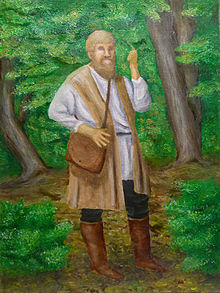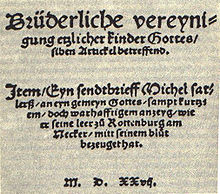- Michael Sattler
-
Michael Sattler (c.1490 – 21 May 1527) was a monk who left the Roman Catholic Church during the Protestant Reformation to become one of the early leaders of the Anabaptist movement. He was particularly influential for his role in developing the Schleitheim Confession.
Born in approximately 1490 in Staufen, Germany.[1] Sattler became a Benedictine monk in the cloister of St. Peter and most likely became prior.[2] He left St. Peter's probably in May 1525 when the monastery had been overcome by the troops from the Black Forest fighting in the peasant's war[3]. He later married a former Beguine named Margaretha.[4] When Sattler arrived in Zurich is not known except that he was in town before being expelled from the city November 18, 1525 in a wave of expulsions of foreigners resulting from the November 6-8 disputation on baptism.[5] Some believe that Sattler is to be identified as the "Brother Michael in the white coat," mentioned in a document dated March 25 of that year,[6] thus placing Sattler in Zurich before Snyder's estimation of when he left St. Peter's.[7] Snyder believed that Sattler possibly arrived in Zurich to attend that disputation.[8] He became associated with the Anabaptists and was probably rebaptised in the summer of 1526. He was involved in missionary activity around Horb and Rottenburg, and eventually traveled to Strasbourg. In February 1527 he chaired a meeting of the Swiss Brethren at Schleitheim, at which time the Schleitheim Confession was adopted.
In May 1527, Sattler was arrested by Count Joachim von Zollern, regent of Archduke Ferdinand of Austria, along with his wife and several other Anabaptists. He was tried and sentenced to be executed as a heretic. The sentence to execution read, "Michael Sattler shall be committed to the executioner. The latter shall take him to the square and there first cut out his tongue, and then forge him fast to a wagon and there with glowing iron tongs twice tear pieces from his body, then on the way to the site of execution five times more as above and then burn his body to powder as an arch-heretic."[9] The other men in the group were executed by sword, and the women, including Margaretha, were executed by drowning.
Contents
See also
- Martyrs Mirror, which includes an account of his death.
Works cited
- Gstohl, Mark (2004). "Michael Sattler". Retrieved May 25, 2006.
- Horsch, John. Mennonites In Europe. Rod and Staff Publishers, 1942, 1995, pp. 70-78. Cited at http://www.anabaptists.org/history/sattler.html
- Snyder, C. Arnold. The Life and Though of Michael Sattler. Scottdale, PA: Herald Press, 1984. ISBN 0-8361-1264-4
- Kauffmann, Karl-Hermann Michael Sattler - ein Märtyrer der Täuferbewegung. Brosamen-Verlag Albstadt 2010 ISBN 978-3-00-0032755-1
- Yoder, John Howard. The Legacy of Michael Sattler. Scottdale, Pennsylvania: Herald, 1973.
Reflist
- ^ John Howard Yoder, The Legacy of Michael Sattler (Scottdale, Pennsylvania: Herald, 1973), 10.
- ^ Ibid.
- ^ C. Arnold Snyder, The Life and Thought of Michael Sattler (Scottdale, Pennsylvania: Herald, 1984), 64.
- ^ Ibid., 101.
- ^ Ibid., 79.
- ^ Leonhard von Muralt and Walter Schmid eds. Quellen zur Geschichte der Täufer in der Schweiz I: Zürich (Zurich: S. Hirzel, 1952), 136.
- ^ e.g. Fritze Blanke, Brothers in Christ: The History of the Oldest Anabaptist Congregation, Zollikon, near Zurich, Switzerland (Scottsdale, Pennsylvania: Herald, 196)1.
- ^ Ibid., 82.
- ^ Hutterite Large Chronicle, quoted in William Roscoe Estep, The Anabaptist Story 3rd ed. (Grand Rapids, Michigan: Wm. B. Eerdmans, 19960, 57.
External links
- Michael Sattler in Global Anabaptist Mennonite Encyclopedia Online
- Memorial stone at location of Michael Sattler's execution in Rottenburg, Germany, Sites of Memory webpage
- Theological Biography of Michael Sattler at BaptistTheology.org
- Two Kinds of Obedience Modern English version of tract usually attributed to Sattler
Categories:- 1490s births
- 1527 deaths
- Benedictines
- Religious persecution
- Protestant Reformation
- People executed for heresy
- People executed by burning
- Christian radicals
- German Anabaptists
- German Christian monks
- Executed German people
- 16th-century Protestant martyrs
Wikimedia Foundation. 2010.


